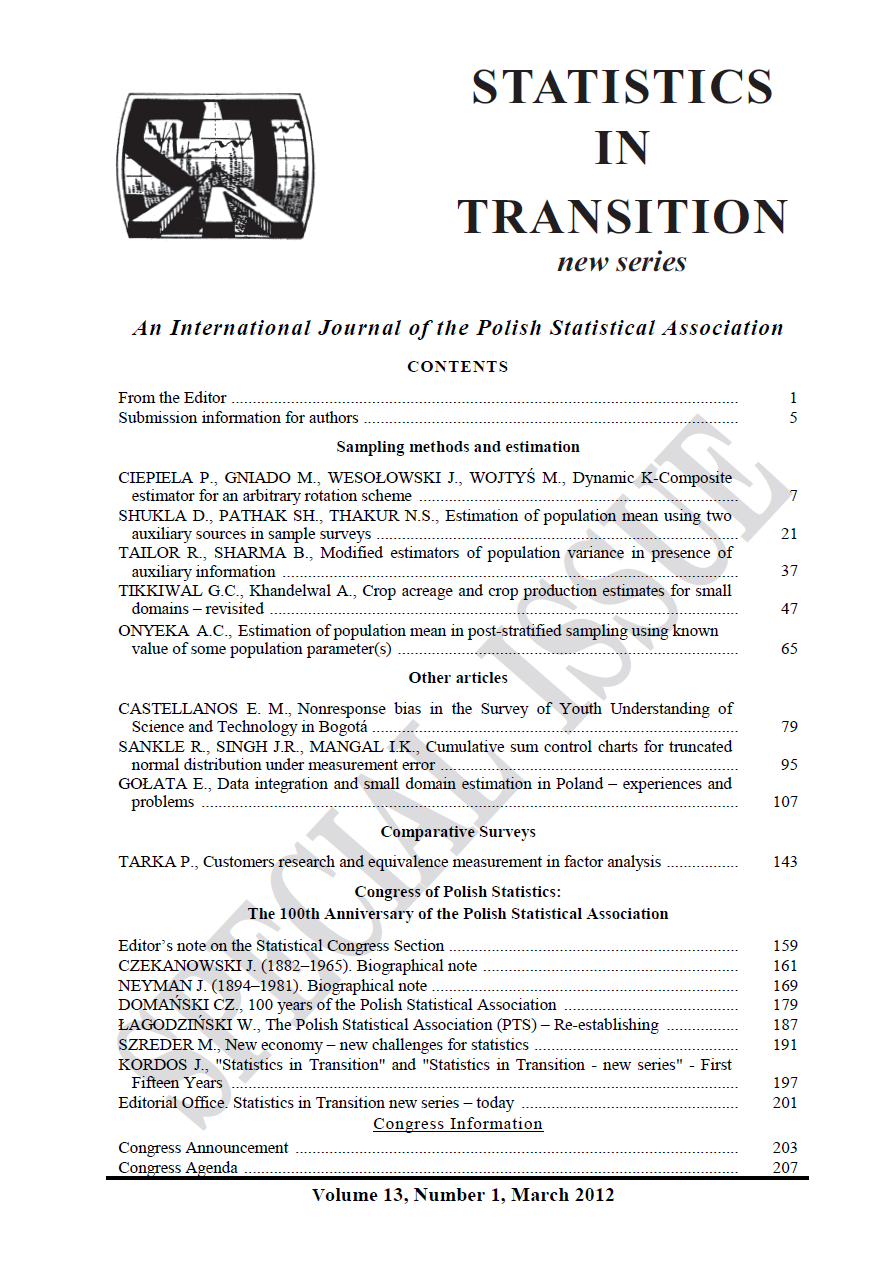ARTICLE
ABSTRACT
This paper proposes families for estimation of population mean of the main variable under study using the information on two different auxiliary variables under simple random sampling without replacement (SRSWOR) scheme. Three different classes of estimators are constructed, examined with a complete study with other existing estimators. The expression for bias and mean squared error of the proposed families are obtained up to first order of approximation. Usual ratio estimator, product estimator, dual to ratio estimator, ratio-cum-product type estimator and many more estimators are identified as particular members of the suggested family. Expressions of optimization are derived and theoretical results are supported by numerical examples.
KEYWORDS
Family of estimators, SRSWOR, Bias and Mean squared error.
REFERENCES
ABU-DAYYEH, W.A., AHMED, R.A. and MUTTLAK, H.A. (2003): Some estimators of finite population mean using auxiliary information, Applied Mathematics and Computation, 139, 287-298.
ANDERSON, T.W. (1958): An introduction to multivariate statistical analysis, John Wiley and Sons, Inc., New York.
COCHRAN, W.G. (2005): Sampling Techniques. John Wiley and Sons, New York.
COCHRAN, W.G. (1940): The estimation of the yields of cereal experiments by sampling for the ratio gain to total produce, Journal of Agricultural Society, 30, 262–275.
COCHRAN, W.G. (1942): Sampling theory when the sampling units are of unequal sizes, Journal of American Statistical Association, 37, 119–132.
DALABEHARA, M. and SAHOO, L.N. (1994): A class of estimators in stratified sampling with two auxiliary variables, Jour. Ind. Soc. Ag. Stat., 50, 2, 144 -149.
DALABEHARA, M. and SAHOO, L.N. (2000): An unbiased estimator in two -phase sampling using two auxiliary variables, Jour. Ind. Soc. Ag. Stat., 53, 2, 134-140.
DESRAJ (1965): On a method of using multi-auxiliary information in sample surveys, Journal of American Statistical Association, 60, 270–277.
HANSEN, M.H., HURWITZ, W.N. and MADOW, W.G. (1953): Sample survey methods and theory, John Wiley and Sons, New York.
KADILAR, C. and CINGI, H. (2004): Estimator of a population mean using two auxiliary variables in simple random sampling, International Mathematical Journal, 5, 357-360.
KADILAR, C. and CINGI, H. (2005): A new estimator using two auxiliary variables, Applied Mathematics and Computation, 162, 901-908.
KHARE, B.B. and SRIVASTAVA, S.R. (1981): A generalized regression ratio estimator for the population mean using two auxiliary variables, The Aligarh Journal of Statistics, 1 (1), 43–51.
MUKHOPADHYAY, P. (2000): Theory and methods of survey sampling, Prentice Hall of India Pvt. Ltd., New Delhi.
MURTHY, M.N. (1964): Product method of estimation, Sankhya, 26, A, 294–307.
MURTHY, M.N. (1976): Sampling Theory and Methods, Statistical Publishing Society, Calcutta.
NAIK, V.D. and GUPTA, P.C. (1991): A general class of estimators for estimating population mean using auxiliary information, Metrika, 38, 11-17.
PERRI, P.F. (2007): Improved Ratio-cum-product type estimator, Statistics in Transition, 8, 1, 51-69.
RAY, S.K. and SAHAI, A. (1980): Efficient families of ratio and product type estimators, Biometrika, 67, 215–217.
SAHOO, J. and SAHOO, L.N. (1993): A class of estimators in two-phase sampling using two auxiliary variables, Jour. Ind. Soc. Ag. Stat., 31, 107-114.
SAHOO, L.N., SAHOO, R.K. (2001): Predictive estimation of finite population mean in two phase sampling using two auxiliary variables, Jour. Ind. Soc. Ag. Stat., 54, 4, 258-264.
SHUKLA, D. (2002): F-T estimator under two-phase sampling, Metron, 59, 1-2, 253-263.
SHUKLA, D., SINGH, V.K. and SINGH, G.N. (1991): On the use of transformation in factor type estimator, Metron, 49, 1-4, 359-361.
SHUKLA, D., THAKUR, N.S., PATHAK SHARAD and RAJPUT, D.S. (2009):Estimation of mean under imputation of missing data using factor-type estimator in two-phase sampling, Statistics in Transition, 10, 3, 397-414.
SINGH, M.P. (1965): On the estimation of ratio and product of the population parameters, Sankhya B, 27, 321-328.
SINGH, M.P. (1965): Ratio cum product method of estimation, Metrika, 12, 34-42.
SINGH, V.K. AND SHUKLA, D. (1987): One parameter family of factor-type ratio estimator. Metron, 45, 1-2, 273-283.
SINGH, V.K. AND SHUKLA, D. (1993): An efficient one parameter family of factor-type estimator in sample survey. Metron. 51, 1-2, 139-159.
SINGH, V.K. AND SHUKLA, D. (1987): One parameter family of factor type ratio estimator, Metron. 45, 1-2, 273-283.
SINGH, V.K. AND SINGH, G.N. (1991): Chain type estimator with two auxiliary variables under double sampling scheme, Metron, 49, 279-289.
SINGH, V.K., SINGH, G.N. AND SHUKLA, D. (1994): A class of chain ratio estimator with two auxiliary variables under double sampling scheme,Sankhya, Ser. B., 46, 2, 209-221.
SRIVASTAVA, S.K. (1971): A generalized estimator for the mean of a finite population using multi-auxiliary information, Journal of American Statistical Association, 66, 404–407.
SRIVASTAVA, S.K. and JHAJJ, H.S. (1983): A class of estimators of the population mean using multi-auxiliary information, Calcutta Statistical Association Bulletin, 32, 47–56.
SRIVENKATARAMANA, T. (1980): A dual to ratio estimator in sample survey,Biometrika, 67, 199–204.
STEEL, R.G.D and TORRIE J.H.(1960): Principles and procedures of statistics, Mc Graw Hill Book Co.
SUKHATME, P.V., SUKHATME, B.V., SUKHATME, S. and ASHOK, C. (1984): Sampling Theory of Surveys with Applications, Iowa State University Press, I. S. A. S. Publication, New Delhi
